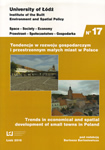Studium struktury przestrzennej małego miasta
A STUDY OF THE SPATIAL STRUCTURE OF A SMALL TOWN
Author(s): Szymon OpaniaSubject(s): Economy, Geography, Regional studies, Rural and urban sociology
Published by: Wydawnictwo Uniwersytetu Łódzkiego
Keywords: Spatial structure;analysis of the problems;spatial planning
Summary/Abstract: The concept of small town contains meanings that seem to be important from the point of view of spatial structure analysis. ‘Small’ refers to the numer of inhabitants, which is the basis for including a city in a certain size group. ‘Town’ or ‘city’ in the basic sense can be considered as a historically shaped settlement unit. The components of the city: buildings, public spaces, technical infrastructure, urban composition and an active community make up urban space and the life in it – the essence of urbanity. Silesian voivodeship contains 35 urban settlements which can be categorized as small towns. The smallest of them is Sośniowice with about 2 000 inhabitants, and the largest is Orzesze with a population of 19 199. So the question is whether the size of a city affects the quality of life in the city? And are the conditions in the largest of them – Orzesze – better than in other, smaller towns? The aim of the article is thus an attempt to demonstrate the usefulness of the study of cities’ spatial structure as a tool in the field of spatial planning and urban design, allowing to answer the stated question and identify possible corrective actions aimed at improving the quality of life in the city.W województwie śląskim zlokalizowanych jest 35 miast kwalifikujących się do grupy miast małych, z czego najmniejsze – Sośnicowice liczą poniżej 2 tys. mieszkańców, zaś Orzesze z liczbą 19 199 mieszkańców jest największym małym miastem w grupie. Pojawia się więc pytanie, czy wielkość miasta ma wpływ na jego miejskość? I czy największe z nich – Orzesze jest „bardziej miejskie” od pozostałych mniejszych miast? Celem artykułu jest próba wykazania przydatności diagnozy struktury przestrzennej miasta, jako narzędzia z dziedziny planowania przestrzennego i urbanistyki, pozwalającego dać odpowiedź na postawiony problem, jak i wskazać ewentualne działania zmierzające do podniesienia jakości życia w mieście.
Journal: Space – Society – Economy
- Issue Year: 2016
- Issue No: 17
- Page Range: 49-66
- Page Count: 18
- Language: English, Polish

